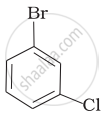Advertisements
Advertisements
प्रश्न
Arrange the following compounds in the increasing order of their densities.
(a)

(b)

(c)

(d)

पर्याय
(a) < (b) < (c) < (d)
(a) < (c) < (d) < (b)
(d) < (c) < (b) < (a)
(b) < (d) < (c) < (a)
उत्तर
(a) < (b) < (c) < (d)
Explanation:
The density increases with increase in number of carbon atoms, halogen atoms and atomic masses of the halogen atoms bounded with the alkyl or aryl groups. Or, in other words density is related to molecular mass of the compound. Higher the molecular mass, greater will be the density of the compound.
APPEARS IN
संबंधित प्रश्न
Arrange the set of compounds in order of increasing boiling points.
Bromomethane, Bromoform, Chloromethane, Dibromomethane.
Explain why alkyl halides, though polar, are immiscible with water?
How many structural isomers are possible for a compound with the molecular formula C3H7Cl?
Which of the following halide is 2°?
Which of the following possesses the highest melting point?
Reaction of \[\ce{C6H5CH2Br}\] with aqueous sodium hydroxide follows ______.
Write the structure of the following organic halogen compound.
4-tert-Butyl-3-iodoheptane
Write the structure of the following organic halogen compound.
4-tert-Butyl-3-iodoheptane
Name the following halides according to the IUPAC system and classify them as alkyl, allyl, benzyl (primary, secondary, tertiary), vinyl or aryl halide:
\[\ce{CH3 C(C2H5)2CH2Br}\]
Write the structure of the following organic halogen compound.
4-tert-Butyl-3-iodoheptane
